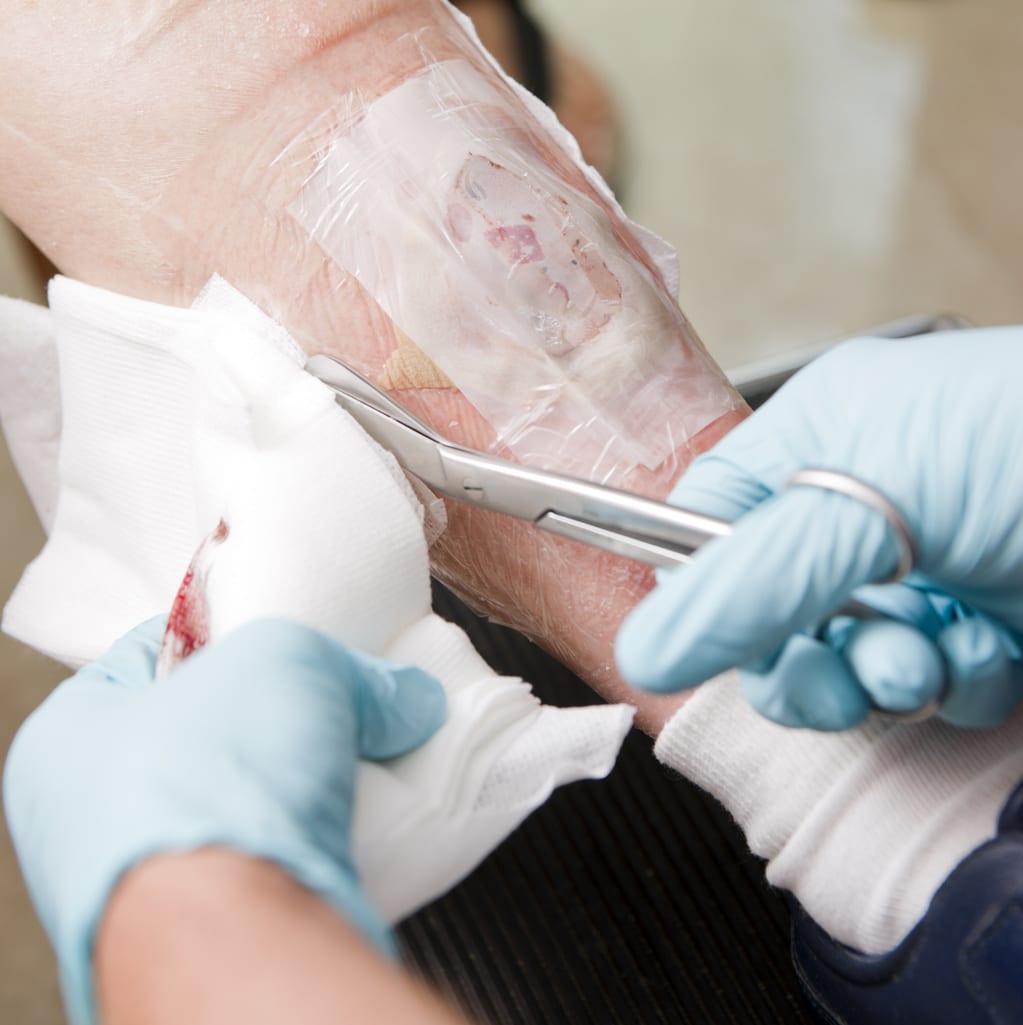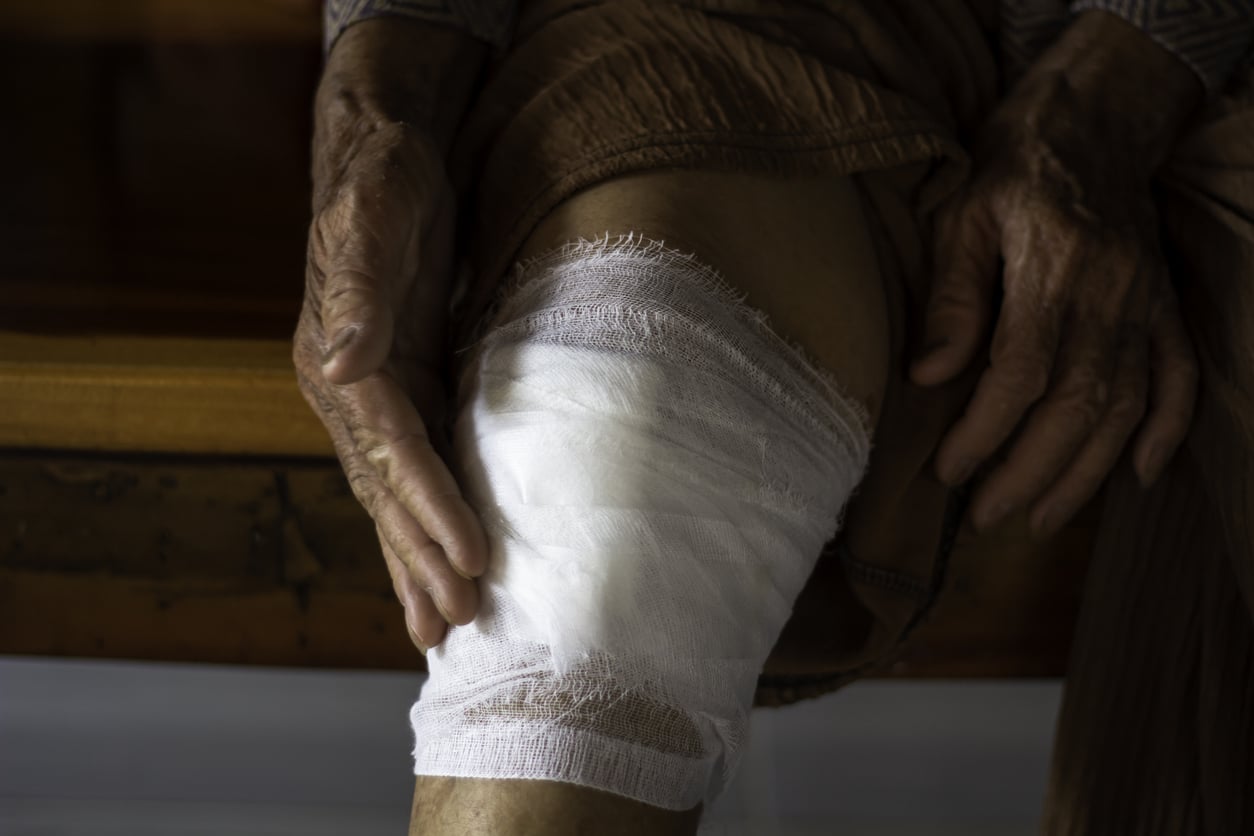Leg Ulcer Treatments
Comprehensive Care for Leg Ulcer Treatment at Coastal Vascular Center
Venous ulcers represent a challenging and often painful consequence of poor leg circulation, commonly stemming from persistent venous insufficiency. These open wounds typically emerge on the lower extremities – the legs, ankles, or feet – and are notorious for their reluctance to heal promptly, raising the risk of further complications, like skin infections and significant discomfort. Coastal Vascular Center stands at the forefront of tackling these complex conditions brought on by chronic vascular disorders.
We understand the distress and hindered quality of life that comes with venous ulcers, and our mission is to offer thorough, personalized care focused on eradicating the distressing symptoms and long-term complications of venous insufficiency. Our dedicated team at Coastal Vascular Center is equipped with the advanced knowledge and technology vital to effectively manage and treat conditions like varicose veins and venous ulcers.
At our center, patients receive more than just treatment; they experience a renewed sense of hope and a clear path to recovery. Trust in the expertise of Coastal Vascular Center to guide you back to healthier legs, improved well-being, and a life free from the limitations of leg ulcers.
Understanding Leg Ulcers
Leg ulcers are persistent wounds or open sores that typically develop on the lower part of the leg or around the ankle. These ulcers can manifest as a result of poor blood circulation, primarily due to venous insufficiency, where the veins in the legs fail to return blood back towards the heart efficiently. Such circulatory problems can lead to increased pressure in the veins, causing fluid to leak into surrounding tissues, eventually leading to ulceration if left untreated.
What Causes Leg Ulcers?
The most common cause of leg ulcers is chronic venous insufficiency. This condition arises when the valves in the leg veins that prevent blood from flowing backward become weakened or damaged. Other vascular conditions such as peripheral arterial disease (PAD), diabetes, and hypertension can also contribute to the formation of ulcers by impairing blood flow to the lower extremities.
Types of Leg Ulcers
Venous Ulcers: the most prevalent and typically appear just above the ankle. They can be painful and cause swelling, itching, and a heavy-leg feeling.
Arterial Ulcers: Caused by poor blood supply to the legs due to arterial disease, these ulcers can be excruciating and usually occur on the feet and toes.
Diabetic Ulcers: Common in individuals with uncontrolled diabetes, these ulcers stem from nerve damage and poor circulation.
Take the First Step Towards Healing
Don’t let leg ulcers affect your quality of life. Contact Coastal Vascular Center today to schedule your consultation.
Causes of Leg Ulcers
The most common causes of leg ulcers are chronic venous insufficiency (CVI) and arterial insufficiency. CVI occurs when the veins in the legs are damaged or weakened, causing blood to pool in the legs. This can lead to swelling, skin discoloration, and ulcers. Arterial insufficiency, on the other hand, occurs when the arteries in the legs are narrowed or blocked, reducing blood flow to the legs and feet. This can cause pain, skin changes, and ulcers.
Other causes of leg ulcers include:
- Diabetes
- Obesity
- Trauma or injury to the leg
- Infection
- Peripheral Arterial Disease
- Autoimmune disorders
- Cancer
For more information, please read our article on the seven causes of leg ulcers.
What Does A Leg Ulcer Look Like?
Venous insufficiency ulcers and venous stasis ulcers have an appearance that is easy to recognize:
- Typically shallow
- Appear red at the bottom
- Sometimes painful and tender to the touch
- May ooze or drain fluid; the amount depends on the size and severity of the ulcer
- Start small but can become quite large
- Multiple ulcers can occur at the same time
Symptoms of Leg Ulcers
The symptoms of leg ulcers can vary depending on the underlying cause, but they typically include:
- Pain or tenderness in the affected area
- Redness or discoloration around the ulcer
- Swelling in the legs or feet
- Itching or burning sensation
- Drainage or pus from the ulcer
- A foul-smelling odor
Advanced Leg Ulcer Treatment Strategies at Coastal Vascular Center
Leg ulcers, a complication arising from venous insufficiency, require a nuanced approach to treatment that addresses both the ulcers’ immediate challenges and their underlying causes. At Coastal Vascular Center, we offer an expansive range of treatment modalities individually tailored to the severity of the venous ulcers and the extent of associated venous disease. Treatment begins with necessary immediate local wound care, which is particularly beneficial for individuals experiencing venous ulcers for the first time or those presenting with only mild venous disease symptoms.
Our comprehensive treatment plan focuses on several key directives designed to combat ulceration from multiple angles:
Enhancing Circulation
To promote better lower body circulation, which is pivotal in managing and healing venous ulcers, we employ techniques such as compression therapy through a medical-grade compression hose. This is complemented with recommendations for leg elevation and moderate physical activity, such as short walks, that encourage vascular health without overexertion. Post-treatment, ongoing compression therapy may be advisable as a preventive measure against the recurrence of venous ulcers.
Infection Control
The risk of skin infections adjoining venous ulcers is significant, and preventive strategies are as crucial as proactive treatment. Our approach may include antibiotic therapy tailored to the specific needs of the patient, coupled with over-the-counter options to alleviate discomfort and inflammation. We aim to facilitate a more comfortable and swift healing process by managing these complications effectively.
Wound Debridement
The presence of non-viable tissue within and around venous ulcers can impede the body’s innate capacity to regenerate healthy cells. Debridement is a carefully executed procedure our specialists may opt for, wherein dead or unhealthy tissue is meticulously removed. This procedure not only encourages the growth of fresh, healthy tissue but also expedites the overall healing timeline.
At Coastal Vascular Center, we understand that treatment of venous ulcers extends beyond the wound itself, necessitating a holistic view of the patient’s vascular health. Our team is dedicated to providing targeted, effective treatment plans, state-of-the-art techniques, and a compassionate approach to care, offering patients a robust foundation for healing and preventing future ulcerations. We are relentlessly committed to restoring both the health and comfort of our patients’ legs, helping them reclaim an active and fulfilling life free from the burden of chronic venous ulcers.
Rediscover Comfort with Coastal Vascular Center’s Expert Ulcer Care
If you or a loved one are experiencing symptoms of leg ulcers or suffering from persistent wounds that don’t seem to heal, don’t wait for the situation to worsen. Early intervention is key to effective treatment and can prevent complications. At Coastal Vascular Center, our dedicated team of vascular experts is ready to provide you with personalized care tailored to address your specific needs. We utilize state-of-the-art technologies and the latest treatments to ensure the best possible outcomes.
Take the First Step Towards Healing
Don’t let leg ulcers affect your quality of life. Contact Coastal Vascular Center today to schedule your consultation. Our compassionate and knowledgeable staff will guide you through every step of your journey towards recovery, from diagnosis to treatment and beyond.
📞 Call us now at 713-999-6056 to make an appointment. Let us help you walk confidently towards a future free from the pain and discomfort of leg ulcers. Your health can’t wait, and at Coastal Vascular Center, neither should you.
Leg Ulcer Articles
Unveiling the Mystery of Leg Ulcers
Leg ulcers are not just wounds; they are a window to your vascular health and a call for immediate attention. These persistent sores that refuse to heal can start as a minor cut or as an area deprived of essential nutrients and oxygen due to poor blood circulation....
Understanding the Link Between Venous Ulcers and Venous Insufficiency
Venous insufficiency is a common condition that can lead to the development of painful and hard-to-heal ulcers. These ulcers, also known as venous ulcers, occur when veins in the legs have difficulty pumping blood back to the heart, causing blood to pool in the...
What Are Venous Stasis Ulcers & How Can They Be Treated?
Venous stasis ulcers, also called "venous leg ulcers," are wounds on the skin. They are due to a pooling of blood in veins. These ulcers happen most often on the legs. Usually, mild injuries and wounds heal with time. The average time it takes for people to recover...
Seven Causes of Leg Ulcers and Your Treatment Options
Leg ulcers are no joke. As many as 1.69% of Americans experience leg ulcers at some point in their lives. Ulcers can cause significant pain and tissue damage, and they can lead to amputation. If you want to keep your legs safe, you should know about...


